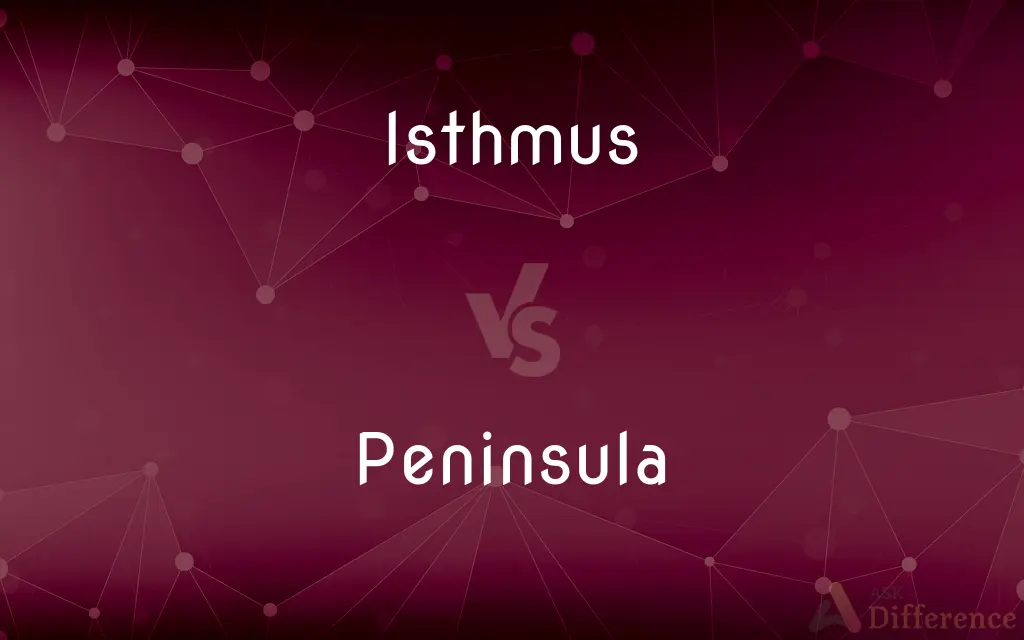Isthmus vs. Peninsula — What's the Difference?
By Tayyaba Rehman — Updated on September 22, 2023
An isthmus is a narrow strip of land connecting two larger land areas, while a peninsula is a piece of land surrounded by water on three sides but still connected to mainland. Both are unique geographical features.

Difference Between Isthmus and Peninsula
Table of Contents
ADVERTISEMENT
Key Differences
An isthmus and peninsula are both geographical terms, but they describe different types of landforms. An isthmus refers to a slender land bridge that joins two larger areas of land and is generally surrounded by water on two sides. The significance of an isthmus often lies in its strategic importance, serving as a link between two land masses. The Panama Isthmus, for instance, connects North and South America.
On the other hand, a peninsula is essentially a projection of land that juts out into the water, with water enveloping it on three of its sides while remaining attached to a mainland on the fourth. This unique characteristic allows peninsulas to have varied climates and ecosystems, given their exposure to water bodies. The Florida Peninsula, which extends into the Atlantic Ocean and the Gulf of Mexico, is a classic example.
Understanding the difference between an isthmus and peninsula is essential in geography. While both are associated with water, their connection to larger land masses differs. An isthmus acts as a connector, bridging two large areas, while a peninsula appears almost as an extension of the mainland, reaching out into a sea or ocean.
When exploring the world's diverse landforms, recognizing the distinction between an isthmus and peninsula can enhance one's comprehension of global geography. Both these formations have played crucial roles in shaping human civilization, with many important cities and ports situated on or near them, due to their strategic and ecological importance.
Comparison Chart
Definition
Narrow strip of land between two bodies of water, connecting two larger areas.
Landform surrounded by water on three sides but connected to mainland.
ADVERTISEMENT
Surrounded By
Water on two sides.
Water on three sides.
Function
Connects two larger land masses.
Extends from mainland into water.
Examples
Panama Isthmus.
Florida Peninsula.
Strategic Value
Often significant for transportation and trade.
Can have diverse ecosystems due to proximity to water.
Compare with Definitions
Isthmus
A constricted portion of land or tissue.
The isthmus in the thyroid gland is the connecting tissue between its two lobes.
Peninsula
Often characterized by unique climates due to proximity to water.
The peninsula benefits from milder temperatures because of the surrounding sea.
Isthmus
A narrow land bridge between two larger territories.
The Isthmus of Panama is a crucial connector between North and South America.
Peninsula
A landform surrounded by water on three sides.
The Italian Peninsula juts out into the Mediterranean Sea.
Isthmus
Land surrounded by water on two sides, connecting larger areas.
The isthmus provided the perfect route for building a canal.
Peninsula
An extended portion of mainland into a sea or ocean.
The peninsula offers breathtaking views of the sunset over the ocean.
Isthmus
Often a vital point for transportation and commerce.
The creation of a canal across the isthmus changed global trade routes.
Peninsula
A geographical feature providing strategic ports and harbors.
The peninsula has several bustling port cities due to its access to open water.
Isthmus
A geographical formation often sought after for its strategic value.
Countries battled for control over the isthmus due to its significance.
Peninsula
Land projecting into a body of water from a larger land mass.
The peninsula's beaches are a major tourist attraction.
Isthmus
An isthmus ( or ; plural: isthmuses or isthmi; from Ancient Greek: ἰσθμός, romanized: isthmós, lit. 'neck') is a narrow piece of land connecting two larger areas across an expanse of water by which they are otherwise separated. A tombolo is an isthmus that consists of a spit or bar, and a strait is the sea counterpart of an isthmus.
Peninsula
A peninsula (Latin: paeninsula from paene 'almost' and insula 'island') is a landform surrounded by water on most of its border while being connected to a mainland from which it extends. The surrounding water is usually understood to be continuous, though not necessarily named as a single body of water.
Isthmus
A narrow strip of land connecting two larger masses of land.
Peninsula
A piece of land almost surrounded by water or projecting out into a body of water.
Isthmus
A narrow strip of tissue joining two larger organs or parts of an organ.
Peninsula
A piece of land that juts out from a larger land mass and is mostly surrounded by water.
Isthmus
A narrow passage connecting two larger cavities.
Peninsula
(geography) A piece of land projecting into water from a larger land mass.
Isthmus
A narrow strip of land, bordered on both sides by water, and connecting two larger landmasses.
Isthmus of Suez
Peninsula
A portion of land nearly surrounded by water, and connected with a larger body by a neck, or isthmus.
Isthmus
(anatomy) Any such narrow part connecting two larger structures.
Uterine isthmus
Peninsula
A large mass of land projecting into a body of water
Isthmus
(graph theory) An edge in a graph whose deletion increases the number of connected components of the graph.
Isthmus
A neck or narrow slip of land by which two continents are connected, or by which a peninsula is united to the mainland; as, the Isthmus of Panama; the Isthmus of Suez, etc.
Isthmus
A relatively narrow strip of land (with water on both sides) connecting two larger land areas
Isthmus
A narrow band of tissue connecting two larger parts of an anatomical structure
Common Curiosities
Can an isthmus be part of a peninsula?
Yes, an isthmus can be located on a peninsula, further connecting it to another land mass.
What is the main difference between an isthmus and a peninsula?
An isthmus connects two land masses and is surrounded by water on two sides, while a peninsula is surrounded by water on three sides.
Are isthmuses always natural formations?
While most isthmuses are natural, some can be artificially enhanced or created for purposes like canal construction.
Why are peninsulas significant in geography?
Peninsulas have diverse ecosystems due to their exposure to water and often hold strategic importance for trade and defense.
Is it possible for an isthmus to become submerged underwater?
Yes, changes in sea levels or erosion can lead to the submersion of an isthmus.
Can an isthmus have a significant effect on global trade?
Absolutely, as seen with the Isthmus of Panama and the Panama Canal, which greatly influenced global trade routes.
Do peninsulas always have a coastal climate?
While many peninsulas have coastal climates due to their proximity to water, the exact climate can vary based on location and other factors.
Which is larger, an isthmus or a peninsula?
Typically, a peninsula is larger than an isthmus, but it varies based on the specific geographical features.
Can both isthmuses and peninsulas have strategic importance?
Yes, both can be vital for trade, transportation, and defense due to their unique geographical positions.
Why might a country want to control an isthmus?
Controlling an isthmus can provide strategic transportation routes and influence over regional trade.
Is Florida an example of an isthmus or a peninsula?
Florida is an example of a peninsula.
Are peninsulas found only in specific parts of the world?
No, peninsulas can be found all over the world in various sizes and forms.
Do all peninsulas have beaches?
Not necessarily, though many peninsulas have coastlines that could include beaches, cliffs, or other shoreline features.
What's an example of a famous isthmus?
The Isthmus of Panama, connecting North and South America, is a famous isthmus.
What factors can influence the formation of a peninsula?
Tectonic activity, erosion, sediment deposition, and rising sea levels are among the factors that can influence peninsula formation.
Share Your Discovery

Previous Comparison
Book vs. Novel
Next Comparison
Leggings vs. JeggingsAuthor Spotlight
Written by
Tayyaba RehmanTayyaba Rehman is a distinguished writer, currently serving as a primary contributor to askdifference.com. As a researcher in semantics and etymology, Tayyaba's passion for the complexity of languages and their distinctions has found a perfect home on the platform. Tayyaba delves into the intricacies of language, distinguishing between commonly confused words and phrases, thereby providing clarity for readers worldwide.
















































